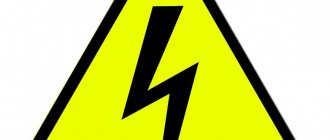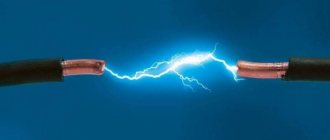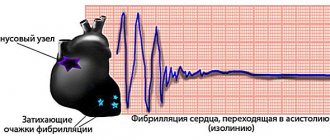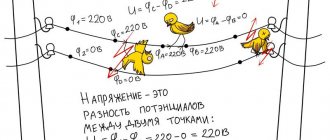The widespread use of electrical equipment in production and in a variety of electrical equipment in everyday life contributes to an increase in the level of electrical injuries, which is accompanied by electric shock. Electric current, under certain conditions, is a dangerous damaging factor that negatively affects the human body. In Fig. Below is a human hand injured by an electric shock.
Electrical injury to the hand
The effect of electric current on the human body
The mechanism of the negative impact of electric current on the human body is complex and diverse. As the current passes through the body, it has the following types of effects:
- Thermal effects, manifested by heating of the skin and tissue of internal organs, up to burns, leading to damage to blood vessels, nerve fibers and the brain and necrosis of tissue in parts of the body. When exposed to thermal effects, sharp functional disorders of human life support systems are observed, for example, sudden bleeding;
- Electrolytic effects, causing electrolysis of lymphatic fluid and decomposition of blood, disrupting the physico-chemical composition of all body tissues;
- Biological impact, expressed in disruption of the normal course of bioelectric processes inherent in living matter. The action of biocurrents that control the internal movements of the tissues of the human body is disrupted, which leads to involuntary unnatural convulsive contractions of the heart muscles and lungs. Living cells and tissues, with which the vitality of the organism is associated, become dangerously excited by the influence of current and may die;
- The mechanical action of an electric current, which causes separation and rupture of tissue due to the explosive formation of steam from blood and lymphatic fluid. The mechanical action provokes strong muscle contractions, up to the rupture of muscle fibers;
- Light effect, characterized by electroophthalmia after exposure to a powerful stream of ultraviolet radiation from an electric arc flash. External signs of electric shock include inflammation of the outer membrane of the eye.
In Fig. Below is an eye with signs of electroophthalmia.
Manifestations of electroophthalmia
The duration of the existence of an electrical circuit through the human body.
The outcome of electric shock is related to the time factor. When analyzing accidents, much attention is paid to this parameter, especially considering the presence of contradictions in the assessment of the dangerous (and safe) time of current passing through a person. On the one hand, there are injuries with a severe outcome even with small currents and a very short duration of current passing through a person (fractions of a second), on the other hand, cases with a favorable outcome (excluding burns) with a duration of injury of several seconds or more.
Due to the above contradictions, it is not possible to strictly substantiate the dependence of the outcome of the lesion on the duration of the existence of the electrical circuit.
Electrical injury concept
Premises according to the degree of danger of electric shock
The pathophysiological result of various effects of electric currents of varying strength on a person is electric shock, interpreted by GOST R IEC 61140-2000 “Protection against electric shock. General safety provisions..." as "...the physiological effect of electric current passing through the human body" (clause 3.1). The entire complex of changes in anatomical relationships in the body, dysfunctions of systems, organs and tissues, accompanied by a corresponding reaction of the body to the action of the current flowing through it, is usually called electrical trauma. In everyday speech, electrical trauma refers to electrical damage that is detected visually (burn) or by the body’s response of the following type:
- a feeling of a mechanical jolt or shock when an electric shock occurs;
- muscle cramps with painful effect;
- cardiac fibrillation, expressed in disruption of the functioning of the heart muscle, up to cardiac arrest and clinical death.
Note! The likelihood of a fatal electric shock falls into the category of implicit dangers, since there are no external attributes and signs of a real impending danger so that people could detect them in advance using their senses (for example, by analogy with a “hot-cold” or “dull-sharp” object).
The severity of electric shock, depending on the body's reaction, is divided as follows:
- First degree – muscle cramps, increased blood pressure, severe dizziness, but without loss of consciousness;
- The second degree is muscle cramps and loss of consciousness, which quickly returns, but the state of fear persists for a long time. Sometimes there is partial paralysis;
- The third degree is convulsions of muscle groups, leading to ruptures of soft tissues and dislocations of joints. Cardiac activity and breathing are impaired, and loss of consciousness occurs. Due to spasm of the vocal cords, the victim is unable to scream for help;
- Fourth degree – paralysis of the respiratory system, fibrillation of the heart muscle. Clinical death.
Important! Clinical death is the transition period that begins from the moment breathing and cardiac arrest stop. The victim of an electric shock has no signs of life, his heart is not working, and there is no breathing. However, in case of electric shock during the period of clinical death, the vital functions of the organs do not immediately fade away, which gives a chance to save a person’s life if appropriate assistance is provided in time - artificial respiration and cardiac massage.
First aid for electric shock
In case of any type of electric shock to the body, it is necessary to provide emergency assistance to the victim, otherwise the health condition may deteriorate significantly and lead to death. The first step is to shut off the power supply using a switch, unscrew the plugs, or, as a last resort, interrupt the current-carrying wiring. If the current flow cannot be stopped, you need to quickly invent isolation for yourself and the victim, then drag them to a safe distance and call for medical help. Before the arrival of honey. workers, if necessary, provide emergency assistance to the victim in the form of cardiopulmonary resuscitation.
Classification of electrical injuries
Safety precautions when handling electric current
Electrical injuries are classified according to the following criteria:
- At the location of the electric shock injury;
In general, three types of traumatic injuries by currents of different origins are defined:
- Industrial electrical injuries - if a person was injured at work while working with equipment powered by electricity;
- Domestic injuries from electricity received in domestic conditions. Mostly, housewives and small children are susceptible to household electrical injuries. The main reasons are ignoring safety requirements when handling household appliances (washing machines, electric microwaves, irons);
- Natural electrical injuries – as a result of exposure to natural electricity. A classic example is a lightning strike, which is a discharge of atmospheric electricity.
In Fig. Below is a typical household electrical injury - a burn to the hand after an electric shock from a faulty electrical appliance.
Household electrical injury
- By the nature of the current (duration of exposure);
The temporary nature of the effect of current leads to two types of electrical injuries:
- Instant electrical injuries resulting from the action of an electric discharge for a short period of time (so-called electric shock). They have life-threatening injuries that require urgent medical attention;
- The chronic course of electrical injuries associated with the long-term and imperceptible influence of electric fields on a person. For example, personnel working near powerful high-voltage generators are susceptible to chronic electrical injuries. Symptoms of chronic damage are manifested in increased fatigue, tremors, high blood pressure, sleep disturbances, and memory impairment.
- Based on the nature of the lesion, the following were determined:
- Local electrical injuries, characterized by local (local) damage to a specific part of the body;
- General electrical injuries, which are extensive damage to the body as a result of electric current flowing through it. With general electrical injuries, cardiac and respiratory arrest may occur, leading to the clinical death of the injured person.
According to statistics, damage from electric shocks is distributed as follows:
- 20% of all cases are local electrical injuries;
- 25% – general injuries;
- 55% are mixed, in which local and general lesions of the body simultaneously appear.
Causes and conditions of injury
They often become:
- Contact with live parts under electrical voltage.
- Contact with electrically live parts due to faulty insulation or protective devices.
- Violation of safety rules when using electrical equipment and electrical installations.
- Entering the step voltage zone.
- Step voltage or step voltage is the voltage formed between two points of the current circuit, located one step apart from each other, on which a person simultaneously stands. The step voltage depends on the resistivity of the soil and the strength of the current flowing through it; it has a maximum value near the point of the fault. At a distance of over 8 meters it poses virtually no danger. To avoid injury in the step electrical voltage zone, it is necessary to take small steps, without lifting your legs from each other.
Types of local electrical injuries
Local electrical injuries (hereinafter referred to as ME) are pronounced local violations of the anatomical integrity of tissues, including bone, caused by the damaging effects of electric current and arc. In most cases, ME is cured, and the functions of the victim’s organs are partially or completely restored. Cases of death from ME are quite rare, most often death occurs from a severe burn. The danger of ME and the complexity of treatment are assessed according to the following factors:
- location, nature and extent of tissue/tissue damage;
- the body's response to local damage.
Types of electric shock
The most typical types of ME are:
- Electrical burns, which are the result of thermal aggression of electric current as it flows through the body;
- Electrical signs (marks), represented by compacted areas of pale yellow color in the form of sharply defined spots on the skin of an electric shock victim. May appear as a cut or puncture wound, or as a charred area on the body. In the area with the electrical mark, the skin loses sensitivity;
- Metallization of the skin, caused by the penetration into the upper layers of human skin of microparticles of metal melted during the burning of an electric arc, or charged metal particles from baths with electrolyte;
Additional Information. When a short circuit occurs or the switch is turned off under load, a powerful heat flow is generated, which initiates the melting of the metal of the current-carrying elements. The dynamic forces that arise during a short circuit spray particles of molten metal, which fly around at high speed.
- Mechanical damage as a result of uncontrolled sharp convulsive muscle contractions during electric shock. There are dislocations of joints and ruptures of ligaments, ruptures of nerve fibers and blood vessels;
- Electroophthalmia.
Let's take a closer look at electrical burns as the most common ME.
Electrical burns
Electrical burns account for almost 60% of all MEs. According to the conditions of origin, electrical burns are divided into two categories of injuries:
- current (or contact) burn injuries that occur during the flow of electric current directly through the human body when a person comes into direct contact with current-carrying elements;
- arc burns caused by damage from an electric arc.
In Fig. Below is an example of an arc flash captured by a CCTV camera.
Arc Flash
Electrical burns occur in electrical installations with low voltage, not exceeding 2 kV. Higher voltages usually produce a spark or arc that causes burns. According to the severity of the injury, electric burns are divided as follows:
- I degree - minor damage to the upper layers of the skin epidermis, redness and swelling of the skin without blistering. The injury can be easily healed at home and sometimes does not even require treatment;
- II degree - along with the usual damage to the upper layer of the skin, blisters filled with yellowish exudate appear (in everyday life, blisters from a burn are simply called blisters). For small burn areas, inpatient treatment at home is quite sufficient;
- III degree - the skin is affected throughout its entire thickness with the development of necrosis, which does not allow its independent regeneration (necrosis of the skin and subcutaneous tissue);
- IV degree – complete necrotic damage to the skin, tissue, muscles, bones and tendons. Visually, the consequences are expressed by charred limbs and other parts of the body.
Important! Surgery is required to treat third and fourth degree burns.
In Fig. The following illustrates the extent of electrical burn injuries.
Severity of electrical burns
There is no need for current to pass through a person for arc burns to occur. When an arc burns, a powerful flow of thermal energy is generated, which can cause severe burns up to degrees III and IV.
Electrical resistance of the human body.
The electrical resistance of the circuit through which current passes through the human body consists of the electrical resistance of the active and inductive wires; electrical resistance of machines, devices or devices that are connected in series with the human body; electrical resistance of the transition contact between live parts of the equipment touched by a person; the human body's own electrical resistance.
The resistance of the human body is a complex complex of biophysical, biochemical and other phenomena. It is usually divided into two parts: skin and blood vessel resistance and nerve resistance. The top layer of skin has a noticeable resistance compared to the resistance of the internal organs. The presence of sweat glands in the skin greatly changes its electrical resistance. There is very little nerve resistance. It is this component of the total resistance that plays the most significant role in current conduction, and therefore in the outcome of electrical injury. The electrical resistance of a living organism is influenced by a large number of factors. The condition of the skin is of significant importance: damage to the stratum corneum (pores, scratches, abrasions and other microtraumas); hydration with water or sweat; contamination with various substances, especially those that conduct electricity well (metal or coal dust, scale, etc.).
The resistance of the human body, i.e. the resistance between two electrodes applied to the surface of the body, can be conventionally considered to consist of three resistances connected in series: two resistances of the outer (horny) layer of the skin and one, called the internal resistance of the body, which includes the resistance of the inner layer of the skin and resistance of internal body tissues. In general, these resistances have active and capacitive components.
In practical calculations, it is necessary to know and evaluate the numerical values of the resistance of a human electrical circuit between two electrodes applied to the body. Type of current and voltage. Research (see Table 1) and the practice of operating electrical installations show that direct current, compared to alternating current of the same values, is less dangerous for humans. This is explained primarily by the fact that due to the presence of a capacitive component in the electrical resistance of the human body, the current density, and therefore the field strength in the tissues, will be greater at equal voltages in the case of alternating current damage than in the case of direct current damage. Another significant circumstance is that with alternating current the damaging amplitude voltage can be 1.4 times greater than the effective voltage. And finally, the probability of the formation of an electrical circuit through vulnerable points with alternating current is greater than with direct current, because alternating current networks cover an incomparably larger number of installations, moreover, the most diverse ones, while direct current networks have more limited and specialized applications.
What has been said about the relative danger of injury from direct and alternating currents is true only for small voltages of the order of 250 - 300 V. At higher voltages, direct current is more dangerous than alternating current with a frequency of 50 Hz, due to the possibility of throwing the victim away from live parts under high voltage , which is extremely rarely observed with similar alternating current injuries. The thrown person may receive mechanical injury, which may result in death (for example, in a fall).
In general, it should be noted that the question of the comparative danger to humans of alternating and direct current needs further study, which will expand our understanding of the biophysics of electrical injury.
Voltage applied to an electrical circuit leads to the transformation of electrical phenomena into other phenomena, the impact of which on the human body directly causes one or another outcome of the lesion. There is an opinion that the outcome of electric shock depends on the network voltage: the higher the voltage, the more dangerous the consequences of electrical injury. In statistical reports, electrical injuries are recorded and subdivided by network voltage values. Based on the same criteria, data are analyzed and electrical injuries are classified, research and experiments are conducted. Meanwhile, such a study of electrical trauma does not always give a correct idea of this damaging factor.
Our current Rules divide all installations into voltages below and above 1000 V. In installations with voltages above 1000 V, the main cause of fatal injuries is burns caused by the passage of electric current. In installations below 1000 V, the main cause of damage is due to the direct effect of current. Statistics show that fatal electrical injuries occur predominantly in installations up to 1000 V.
Fatal injuries also occur at low voltages (65, 36, 24, 12 V). Their analysis shows that they are caused not only by fibrillation current, which cannot be obtained at these voltages. Damages from 12 to 65 V can lead to death only under special circumstances, for example, if the electrical circuit occurs through places vulnerable to current, if environmental conditions are unfavorable. There are also other possible causes of death that have not yet been sufficiently studied.
Summarizing what has been said regarding the absence of a direct relationship between the outcome of the injury and voltage, current, we state that it is impossible to standardize with high accuracy in industry (and in everyday life) dangerous and safe threshold values of current and voltage.
General electrical injuries
General electrical injuries (hereinafter referred to as GE) are characterized by damage to two or more parts of the body or several internal organs at once. A direct threat to the life of the body is posed by disturbances in the normal functioning of various life support systems, including the functioning of the heart, brain and central nervous system.
The damaging potential of electric current depends on the following main factors:
- Type of current (alternating or direct) and frequency of current;
- Current strength and applied voltage;
- Current duration;
- Electric current paths;
It is customary to distinguish the following loops of the probable passage of current through the body (see figure below):
- pos. 1 – “hand-to-hand”;
- pos. 2 – “left arm and legs”;
- pos. 3 – “right arm-leg”;
- pos. 4 – “arms and legs”;
- pos. 5 – “leg-leg”;
- pos. 6 – “head-legs”;
- pos. 7 – “head-hand”;
- pos. 8 – “head-leg”.
Possible paths of current through the body
The most dangerous in terms of the degree of damage are considered to be the “head-arm” (pos. 7) and “head-leg” (pos. 8) loops, which are characterized by the passage of current through the brain and spinal cord. The least dangerous is the “leg-leg” loop (position 5), which practically does not affect vital organs.
- Resistance of the human body and the condition of the skin;
- Individual characteristics of the human body;
- Ambient air humidity.
Accidents associated with electric shock can be avoided if you strictly follow safety requirements when operating electrical equipment or do not use faulty household electrical appliances (for example, in everyday life they often neglect to carefully connect wires to sockets, using exposed wires, which can lead to electrical injury). Proper design, installation or repair of electrical devices ensures their safe operation.
In Fig. The following shows dangerous wiring connections to sockets.
Dangerous connection to sockets
Types of Electric Shock
Depending on the outcome of the electric shock, there are 5 types:
- convulsive muscle contractions, the person is conscious;
- convulsive muscle contractions, a person is unconscious, breathing and heart function are present;
- lack of breathing with impaired heart function;
- electric shock, severe respiratory distress, dysfunction of the circulatory and nervous systems, the onset of deep depression which can last from several tens of minutes to several days and ultimately either complete recovery or biological death occurs;
- clinical death, no breathing, cardiac arrest. It is also called imaginary death, lasts 6-8 minutes, and is a transitional state from life to death. After the specified time, if resuscitation measures are not carried out, biological death occurs.
Also, the path along which the current passes through the body is also of great importance. with what parts of the body does a person touch the conductive part? Most often, people are “connected” to an electrical circuit in such a way that the current passes through loops: “arm-legs”, “arm-arm”, “leg-leg”, “arm-head”, “legs-head”.
The most dangerous are transmission loops in which the current passes through the most important vital organs: the heart, brain, spinal cord, which also have the least electrical resistance in the body and, accordingly, pass through a greater amount of current. This suggests the obvious conclusions that the most dangerous loops are “arm-crawfish” and the paths passing through the head, and the path “leg-leg” is the least dangerous, but nevertheless this is not so, since in this case stepping tension arises, the legs are paralyzed - the person turns out to be in a supine state and electric shock is caused to the entire body.
There are two options for connecting the body to an electrical circuit:
- biphasic - a person simultaneously touches two phases with parts of the body (Figure 2),
- single-phase – touching the phase and zero point (Fig. 3).
Figure 2 - Scheme of two-phase connection of a person to an electrical network
Where, a is a network with an isolated neutral; b – network with solidly grounded neutral.
A two-phase connection is the most dangerous, since in this option the current depends only on the voltage and human resistance (formula 1) and will have a maximum value than with a single-phase connection (see Figure 3).
Figure 3 - Scheme of single-phase connection of a person to the electrical network (a-b)
Figure 3 - Scheme of single-phase connection of a person to the electrical network (c)
- a – network with isolated neutral;
- b – network with solidly grounded neutral.
- c – network with grounded neutral
In option a in Figure 3, to the human resistance - Rch, the shoe resistance Rob is added, Rp - the floor resistance, the phase insulation resistance - Riz. The formula for current strength will take the following form (formula - 2).
Formula 2 - The strength of the current passing through a person during a single-phase connection with an insulated neutral.
Where:
- Uph – phase voltage, V;
- Rh – human resistance (assumed equal to 1000 Ohms.
When calculating, the least resistance is taken (in case of severe intoxication, with wet or damaged skin);
- Rob – shoe resistance;
- Rп – floor resistance;
- Riz – insulation resistance.
Taking into account that the resistance of the floor-shoes-insulation have orders of magnitude greater values than the resistance of a person, then the current flowing through a person with this option is much weaker and less dangerous than with a 2-phase connection.
In emergency mode (see Figure 3b), when one of the phases short-circuits to the housing or goes into the ground, or a contact occurs in a place with damaged insulation, a person may find himself under full line voltage, the current passing through the body in this case is calculated using formula 3:
Formula 3 – The strength of the current passing through a person during a single-phase connection in emergency mode.
The current value when a person is single-phase connected to a network with a grounded neutral is calculated using formula 4.
Formula 4 - The strength of the current passing through a person during a single-phase connection with a grounded neutral.
Return to content
Medical and biological properties of humans
Analysis of accidents involving electric shock shows that the outcome of the injury is related to the medical and biological characteristics of a person and his state of health. Physically healthy and strong people tolerate electrical injuries more easily than unhealthy and weak people. People suffering from skin diseases, cardiovascular, and nervous diseases are more susceptible to electric current.
Therefore, safety regulations for the operation of electrical installations provide for the medical selection of personnel to service electrical installations. Selection is carried out upon admission to work, periodic examinations are carried out within the time frame established by the Ministry of Health in accordance with the list of diseases and disorders that prevent access to work. Selection also has another goal: to prevent people with diseases from servicing electrical installations that may interfere with their production work or cause erroneous actions that are dangerous for other persons (failure to distinguish the color of a signal due to a visual impairment, inability to give a clear command due to a sore throat or stuttering, etc.).
In addition, safety regulations do not allow persons under 18 years of age and without specific knowledge in the field of electrical safety appropriate to the scope and conditions of the work they perform to service electrical installations.











